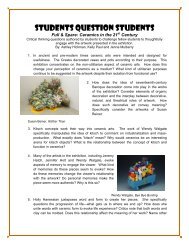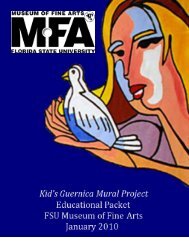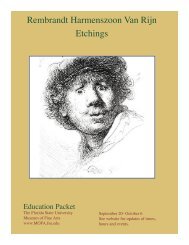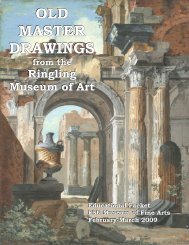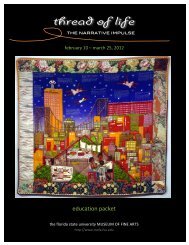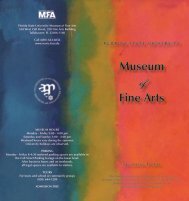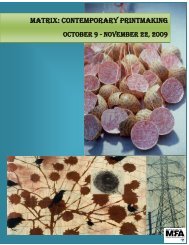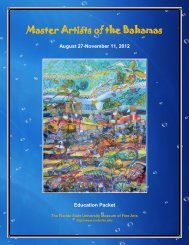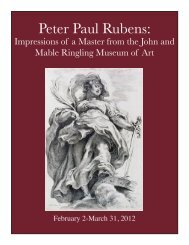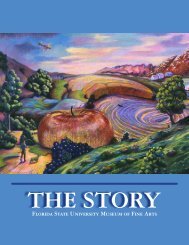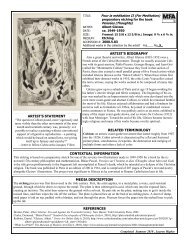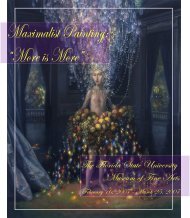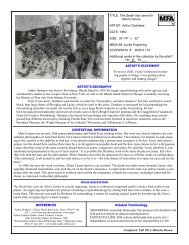Friedl Dicker-Brandeis and Ela Weissberger at Terezin
Friedl Dicker-Brandeis and Ela Weissberger at Terezin
Friedl Dicker-Brandeis and Ela Weissberger at Terezin
- No tags were found...
You also want an ePaper? Increase the reach of your titles
YUMPU automatically turns print PDFs into web optimized ePapers that Google loves.
Objectives:1. Students will have a better underst<strong>and</strong>ing of the reasons the children <strong>at</strong> <strong>Terezin</strong> illustr<strong>at</strong>ed the l<strong>and</strong>scapes, characters <strong>and</strong>scenes in their pieces.2. Students will be able to reflect on their tre<strong>at</strong>ment of line <strong>and</strong> color in their own paintings <strong>and</strong> drawings.3. Students will underst<strong>and</strong> their surroundings can serve as an inspir<strong>at</strong>ion, <strong>and</strong> th<strong>at</strong> wh<strong>at</strong> they see can be transl<strong>at</strong>ed into artby the use of the art elements.4. Students will realize art can communic<strong>at</strong>e emotions <strong>and</strong> thoughts.5. Students will realize th<strong>at</strong> artwork can reflect oppression but can also reflect <strong>and</strong> emphasize tolerance.M<strong>at</strong>erials: Paper, pencils, w<strong>at</strong>ercolor paints, paper towels, cups, w<strong>at</strong>er, brushesActivity Procedure:1. After reading inform<strong>at</strong>ion about <strong>Friedl</strong> <strong>Dicker</strong>-<strong>Br<strong>and</strong>eis</strong> <strong>and</strong> <strong>Ela</strong> <strong>Weissberger</strong>, discuss the background of each <strong>and</strong> theirrel<strong>at</strong>ionship as teacher <strong>and</strong> student.2. Introduce <strong>Friedl</strong> <strong>Dicker</strong>-<strong>Br<strong>and</strong>eis</strong>’s lesson on “draw wh<strong>at</strong> you see,” <strong>and</strong> display examples of the children’s w<strong>at</strong>ercolors<strong>and</strong> sketches from <strong>Terezin</strong>. Discuss the way <strong>Terezin</strong> children’s drawings convey thoughts <strong>and</strong> emotions. Display a list ofthe art elements to which to refer during this discussion.3. Ask the following:A. Ask wh<strong>at</strong> they see in the images.B. Ask if the tre<strong>at</strong>ment of line <strong>and</strong> color adds or takes away from the pieces <strong>and</strong> how so?C. Ask wh<strong>at</strong> emotions the <strong>Terezin</strong> works make them feel <strong>and</strong> the way the children were feeling while making thepieces.4. Compare the images of the artwork to photos of the camp during th<strong>at</strong> time. Ask if the photos <strong>and</strong> the artwork have anyresemblances, if so then how?5. Have the class choose m<strong>at</strong>erials <strong>and</strong> set up the classroom, or go outside to begin working. Have each find one area inwhich to draw, <strong>and</strong> have each focus on portraying it realistically. Students will cre<strong>at</strong>e their own drawings or w<strong>at</strong>ercolorpaintings based on a scene. Ask them to think about using the art elements to help convey their thoughts <strong>and</strong> emotionsabout the subject m<strong>at</strong>ter. For example, reiter<strong>at</strong>e th<strong>at</strong> colors can be suggestive of something <strong>and</strong> th<strong>at</strong> the thickness/tre<strong>at</strong>mentof line can affect an image. Give each a list of the elements to keep on h<strong>and</strong> during the drawing/painting session.6. Ask each student to write a paragraph about the choice of scene <strong>and</strong> the emotions <strong>and</strong> thoughts he/she wished to convey.Ask the student to write the title of the work.7. After everyone has finished, the students will present their works to the class. Ask why each chose th<strong>at</strong> specific narr<strong>at</strong>ive<strong>and</strong> how each chose to illustr<strong>at</strong>e the scene. Have the students describe wh<strong>at</strong> techniques they chose <strong>and</strong> how the art elementshelped get their feelings across. Give them the opportunity to read their paragraphs.8. Sample Questions:a. Can you compare <strong>and</strong> contrast the surroundings in these images to those of the students <strong>at</strong> <strong>Terezin</strong>?b. Wh<strong>at</strong> fe<strong>at</strong>ures of the work from now show tolerance?c. Which fe<strong>at</strong>ures of the work from <strong>Terezin</strong> show oppression?d. Wh<strong>at</strong> in our time cre<strong>at</strong>es tolerance – in our class, in our school, in our country? Is this shown in the artworkcre<strong>at</strong>ed by the students in our classroom?e. Are there ways to show the encouragement of tolerance in these drawings/paintings?f. Wh<strong>at</strong> would you add or include in your work to encourage tolerance in the school environment or the societyas a whole?9. Evalu<strong>at</strong>ion: See General Activity Rubric on pg 20. You can adapt the rubric to this lesson plan as necessary.11



